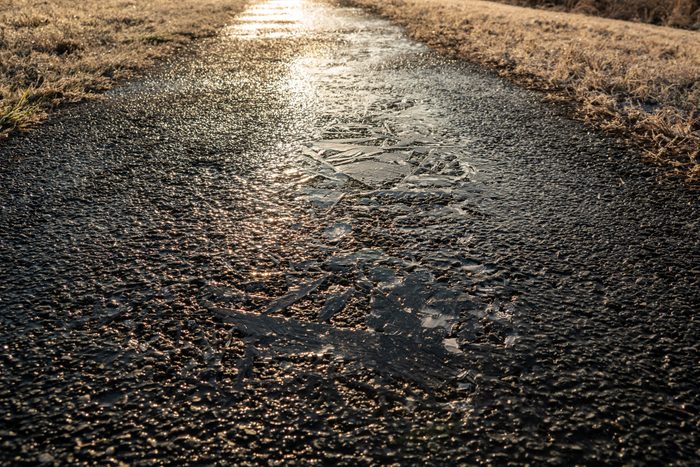How To Remove Black Ice from Driveways and Sidewalks

What is black ice? A layer of nearly invisible ice that makes sidewalks and driveways extremely dangerous. Here's how to take care of black ice before it becomes a problem.
Our editors and experts handpick every product we feature. We may earn a commission from your purchases.
Winter doesn’t officially begin until December 21, but winter weather has a head start on the calendar. The arrival of snow, ice and freezing temperatures mean it’s time to prepare for the various hazards the season brings, like clearing sidewalks and driveways.
Beyond removing snow from those surfaces, another hazard you need to be aware of is black ice. Yep, the same stuff that can make driving dangerous in the winter can also cause problems right in front of your own home.
On This Page
What Is Black Ice?
Black ice is a thin, almost transparent layer of ice that forms on wet surfaces when the temperature drops below freezing.
When snow melts during the day but the mercury drops at night, a thin, transparent layer of ice can form on a surface. It can also happen if the temperature falls below freezing after it rains, as the National Weather Service notes. You need to be especially mindful of it in the morning, when temperatures are usually at their lowest.
It’s most commonly associated with roadways. That’s where the term “black ice” comes from, since the translucent layer of ice forms with the surface of the road visible underneath it.
Slips and falls are a risk on any slick surface, but what makes black ice especially dangerous is that it’s hard to see. That makes preventing it from forming in the first place an especially important task around your home this time of year.
How to Remove Black Ice from Driveways and Sidewalks
Sometimes warming temperatures take care of it for you. Check the forecast to see if and when the temperatures will climb back above 32 degrees, or if the sun will come out and clear the surfaces naturally.
But waiting it out isn’t always the best option. You need to get to work, the kids need to get to school and there could be others walking up the sidewalk.
Applying sand, cat litter or sawdust to icy surfaces provides traction, making it harder to slip. To melt the ice, you’ll need to a deicer.
One problem: Deicers can damage concrete. As ice melts, the water may soak into the concrete, refreeze, expand and cause cracks. New concrete is especially vulnerable. Rock salt, one of the cheapest and most common deicers, is notorious for that. Other deicers contain chemicals that corrode surfaces and other materials.
Of all the deicers available, magnesium chloride is less corrosive and safer for plants and concrete. It’s also a little safer for pets than other deicers. However, the Animal Poison Control Center recommends you don’t let pets eat or lick ice melt. And make sure to wipe it off their paws once they come inside. Psst! Here are the best pet-safe ice melts to use this winter.
How to Prevent Black Ice from Forming
Shovel
The most effective way is also the most laborious — shoveling. If you can keep the snow from building up on your driveway or sidewalk, it can’t melt and re-form as ice. But that’s not always practical, like in a blizzard, where it’s snowing faster than your snow blower or lower back can keep up.
Pre-treat surfaces
Take a page from the airline industry and spread chemical pre-treatments engineered to keep ice from bonding to surfaces. Highway departments buy these products too, applying it to roadways ahead of a storm.
Traditional deicers like rock salt and magnesium chloride can also be used before the snow falls and ice forms. With the deicer spread over sidewalks and driveways, snow melts as it hits the surface, preventing ice formation. Take note, though: If it’s a particularly heavy round of snow, you might need to apply the ice melt during and after, too.
Heated driveways and snow-melting mats
If you live somewhere with lots of snow and ice, consider more complex deicing systems, like heated driveways and mats.
A heated driveway works just like a radiant heating system in houses. Installed under the surface you want to heat, they’re electric or hydronic, meaning they use electricity or water. But that’s an expensive fix, costing thousands of dollars, and it often requires replacing existing surfaces.
Heated mats are a cheaper option, though still more expensive than a good shovel and a bag of salt. Made with slip-resistant rubber and a built-in heating system, you just roll them out on your driveway or sidewalks and turn them on. You’ll need to find a place to store them when the seasons change, and it’s important to keep them clean.


